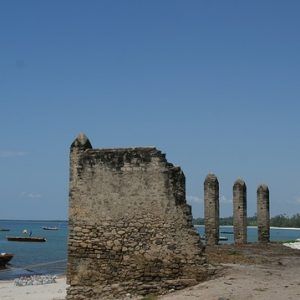Ethiopia has one of the longest histories of any country in Africa. Or to put it more accurately, the Ethiopian highlands boast one of the longest histories of occupation from ancient times.
Ethiopia was a state before Dynastic Egypt overshadowed it in the North. For a few millennia, Egyptian and Ethiopian histories were concurrent. Trade thrived between the two, and extensive cultural interchange took place.
The fall of Egypt after the Late Bronze Age collapse marked the independence of the Ethiopian highlands. Between 1000BC and 1000AD, numerous states came and went, each controlling a small portion of the Ethiopian highlands.
By the 11th century AD, the Aksumite Kingdom – the predecessor of Ethiopia – was already emerging as the world’s first real cosmopolitan civilization. Muslims and Christians resided peaceably within its borders.
Ethiopia had become a melting pot for Arabian and African cultures. But to understand her role in the slave trade, we have to begin with the end in mind.
So, just how was Ethiopia affected by the slave trade?
The Zemene Mesafint in Ethiopia
Ethiopia’s modern history starts in 1855 with Tewodros II’s unification of the country under the New Solomonid Dynasty. The confederacy ended nearly 100 years of majimbo (regionalism) rule in which Ethiopian warlords, not the monarch, had called the shots.
This is what’s called the Zemene Mesafint.
It followed shortly after the end of the golden age of the Ethiopian Empire. After expanding to cover nearly 50% of Africa in 1737, Ethiopia’s border returned to the Ethiopian highlands in the early 19th century.
The vast riches of the Ethiopian Empire had been wiped out by expensive military campaigning in distant lands. The regime was weak, with more military officers than the weakened regime could afford.
Iyoa 1 was the first Ethiopian emperor of the Zemene Mesafint. His reign was marked by widespread in-fighting and an empty treasury. He was murdered at 31 and was followed by a succession of usurpers, military coup leaders, and pawns.
During the Zemene Mesafint, Ethiopia was one of the most dangerous places on earth for the reigning king. Dethronement (and death) was an ever-present danger.
But Ethiopia was not the only nation experiencing this problem. Pretty much every state that existed within Africa prior to 1300 went the same way as Ethiopia between the 14th to 19th centuries.
Africa: A Dark Continent indeed, 1300-1900
The African intellectual gets angry when Africa is referred to as the “Dark Continent” in any context. It is only natural. But upon further study, that is exactly what it was.
It was dark in the same way that any region from which information exchange is not possible or permitted, is dark. And in the period in question (1300-1900) Africa was completely isolated from the rest of the world.
Ethiopia, Egypt, and Constantinople had been ejected from the Holy (Roman) Catholic Church in 1054AD. Because the church was fused to the state and commerce, the schism effectively shut down trade between Africa and Europe.
Shortly thereafter, Islam rose in the Arabian Peninsula, blocking the inland trade route from China to Africa. Apart from Egypt and North Africa, Africa was thus effectively isolated from the rest of the world.
In Europe, a rich variety of mythology informed by lore and fabrications grew around Africa. At home, it was a tranquil Eden for a few centuries, unbothered by outside events.
The kingdoms of Ethiopia, Mali, Congo, Mozambique, and hundreds of others, thrived in various parts of Africa. Communities traded with each other, Ethiopia continued to preach Jesus, and modest accomplishments were made in Alchemy– that old black people science.
The invention of firearms in faraway China was the death keel of Africa. It meant that Africa would not stand a chance when her isolation ended and the hordes came pouring in.
Firearms: A new invention, an upper edge
Explosive weapons were first developed by the Chinese in the 9th century. By 1300, it was the weapon of choice for nearly every army in Europe, the Middle and the Far East.
Of all the inventions ever created by mankind, none has had as great an impact on world events as the gun. On its creation, it became a sort of magic wand for the armies who owned them. All you had to do was wave a few muskets in the face of an inferior army and victory would be yours.
In Europe, Asia, and the Middle East, the empires of the day engaged in constant warfare, both with each other and internally, for a few decades after the discovery. And then they all sort of decided to go to Africa and exert their influence there instead.
Ethiopia at the start of the slave trade
In 1300, Ethiopia (and Africa) was still in isolation from the rest of the world. Perhaps excited by the prospect of wielding firearms, Ethiopian monarchs often sent diplomatic missions to Spain and Portugal.
The favor would not be returned until the start of the slave trade. When Ethiopia finally did get her way, it would cost Africa millions of her citizens.
As we have seen, Ethiopia managed to strengthen her standing in Africa through sheer force of persistent diplomacy. To this aim, Ethiopia’s case was greatly helped by the numerous priceless religious artefacts she owned.
For example, the Ethiopian army claimed ownership of a piece of the original cross of Jesus. It was carried to battle for luck.
Now as Europe reestablished trading ties with African states in the 15th century, Ethiopia was able to exploit her special standing to get in on the firearms business– and become the bully of Africa. For, you see, European merchants did not just sell guns. They bartered them for live humans to work in their newly “discovered” farms in America.
The reserves of indentured servants available dried up fast, necessitating a turn to slave hunting.
Ethiopia (and a few other select communities chosen for the gift of the magical gun) then became a faithful slave hunter for Europe. Her vast conquests in the 17th to 19th century were financed by proceeds from the trans-Atlantic slave trade.
Ethiopia, behind the slave wars era refugee crisis in Africa
To meet the ever-increasing appetite for slaves in America, millions of raids, thousands of battles, and hundreds of wars were fought in Africa . This is the tiny fact that history likes to forget about Africa. As a result, our history does not make sense.
For a period of over 500 years, Africans in every part of the continent could afford to be concerned with one thing only– survival.
As a result, many groups adopted a nomadic way of life. For example, when Ethiopian forces started conducting slave raids in Oromia in the late 15th century AD, the Oromo people moved to northern Kenya.
Here, they lived a mobile life and made a nuisance of themselves to the natives by raiding for food (and slaves) themselves. It was only until Ethiopia was weakened by the Ethiopia-Adal war in 1543 that the Oromo (Galla) finally mobilized and fought their way back to their old homeland.
The constant movement, combined with a pandemic of slave incursions to the interior, created a massive refugee crisis. To this day, the origin and backgrounds of many African ethnicities remain a mystery and a big cause for concern.
From border wars to intertribal conflicts, Africans are still dealing with problems that were created centuries ago during The Dark Age.
Isolated from the rest of the world after the Great Schism, Africa was weakened economically, socially, and academically. It was a dark continent precisely because information exchange was not possible.
You will also love: How the East-West Schism Impacted Ethiopia
Africa must study and solve her issues
We all paid for it with our lives as Africa was routed and plundered from all directions. Even today, we are yet to get back on track. For Africa to light up the future, the issues that have held us back before and continue to hold us back today must be studied and sorted out.
To this end, Ethiopia can be the perfect case study for African history. The empire’s vast tour of conquest brought them into contact with pretty much every other region of Africa.
Ethiopia’s long history also presents us with a glimpse of what was happening elsewhere in the world at every period of history.





